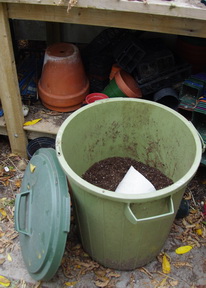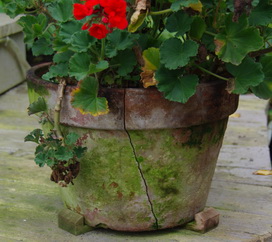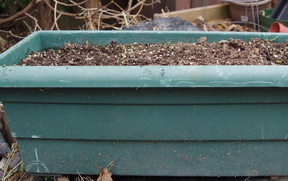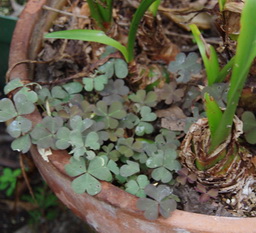|
Overwintering Containers
|

Why Overwinter? I paid a lot of hard earned money for all those bags of soiless mix and hauled them home. Doing all of that in reverse seems very counter productive and the vast majority of that soil is still quite useable. There are really two approaches to dealing with last season’s soil and both have pros and cons. Removing all of the plants and surface junk then dumping all of the containers out, and breaking up any solid root balls may be the best technique for cleaning and preparing the soil. This requires one or more large containers.
Soil Storage? I use plastic garbage cans with lids. (picture right) Now you have to store these buckets of soil as well as the empty containers and next summer you have a collection of empty garbage pails to deal with while they await their winter job. The empty containers, on the other and can now be nested and will take up less room. You do, of course, have to refill all of those containers next spring when there may be lots of other chores requiring your attention.
 Container Types? I grow in many different types of containers and the best technique for overwintering containers varies with the nature of the each pot. Terra cotta is the most sensitive. I have quite successfully left the soil in these containers, covered them so that they don’t become sodden over the winter and had them survive unscathed. Soil that is filled with water will freeze and then expand and that expansion can easily break a terra cotta planter. That is why it is imperative that the soil be well drained and covered if you are going to try this. They will eventually, several year for the sturdiest ones, crack.
Container Types? I grow in many different types of containers and the best technique for overwintering containers varies with the nature of the each pot. Terra cotta is the most sensitive. I have quite successfully left the soil in these containers, covered them so that they don’t become sodden over the winter and had them survive unscathed. Soil that is filled with water will freeze and then expand and that expansion can easily break a terra cotta planter. That is why it is imperative that the soil be well drained and covered if you are going to try this. They will eventually, several year for the sturdiest ones, crack.
Are You A Crackpot? I have actually, carefully, used such cracked containers (pot in picture was cracked when I planted it, adds character?) but at some point they are going to fall apart and make a mess. Terra cotta absorbs a certain amount of moisture and if they are quite damp and filled with soil then they will spall. Fancy term meaning to break up into many smaller bits. I usually try to empty my terra cotta pots and store them under some sort of cover so that they are not absorbing moisture from melting snow. In the soil bin picture, see under the outdoor potting bench.

Is Plastic Better? The many types of plastic pots are easier to deal with. I invariably leave mine filled with soil after pulling out the remains of the plants and cleaning off the surface debris. The roots from your plants will usually compost in the overwintering containers and just be part of the soil in the spring when I fluff it up with a trowel. If you store these in a very dry place then the soil may dry out completely. The peat based soil mixes can be quite a challenge to rewet in the spring. I tend to stack mine up and leave then in a protected location.
Autumn Weeding? The biggest problem I have with this technique is the sometimes significant weed crop that arises after overwintering containers in this way. many weeds survive as seeds but there is also a very insidious container weed that looks like a small clover. (picture below) It is deeply rooted in your containers and spreads under the soil. Try to dig it all out. It can survive all winter with no sun, water or any other encouragement. Lots less work filling and planting in the spring but as in most gardening, nothing comes for free; you will have to watch and weed these containers until the desirable plants out compete them.
 Planted Toilets? We grow plants in everything from old boots to galvanized pails and I have even seen a planted toilet. When overwintering containers we obviously have to look at the structure of each of these and decide between convenience and the destructive capabilities of freezing soil. Metal will rust more quickly if it is constantly wet. The ceramic toilet could probably crack quite readily but I wouldn’t want to have to lift and empty it every year. Are you doing your container gardening at ground level or up twenty stories in an elevator? Consider all of these factors and then decide which course of action you will spend your autumn weekend following.
Planted Toilets? We grow plants in everything from old boots to galvanized pails and I have even seen a planted toilet. When overwintering containers we obviously have to look at the structure of each of these and decide between convenience and the destructive capabilities of freezing soil. Metal will rust more quickly if it is constantly wet. The ceramic toilet could probably crack quite readily but I wouldn’t want to have to lift and empty it every year. Are you doing your container gardening at ground level or up twenty stories in an elevator? Consider all of these factors and then decide which course of action you will spend your autumn weekend following.

New Soil When? I have some concrete planters on my front porch, protected from most of the snow by the porch roof. They have had the same soil in them for at least ten years. I add some compost or new soil most years to make up for the soil that disappears. The Impatiens grew as well in them this year as in any of the previous years. The soil in most containers is simply there to physically hold the plants up and to act as a reservoir for the soil and fertilizer that we supply. The inherent nutrient value of container soil is negligible so continually reusing it is usually not a horticultural issue but a convenience issue. That said, it is possible but unlikely that the soil could become infected with some soil borne pathogen. It’s never happened in all of my years of growing and overwintering containers.
return from Overwintering Containers to containers main page
